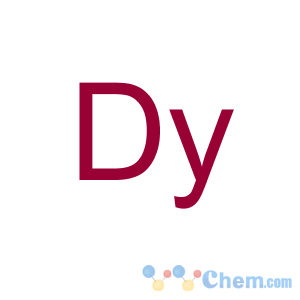Title: Dysprosium
CAS Registry Number: 7429-91-6
Literature References: Dy; at. wt 162.500; at. no. 66; valences 2, 3, 4. A lanthanide; belongs to the yttrium group of rare earth metals. Naturally occurring isotopes (mass numbers): 156 (0.06%); 158 (0.10%); 160 (2.34%); 161 (18.9%); 162 (25.5%); 163 (24.9%); 164 (28.2%); known artificial radioactive isotopes: 145-155; 157; 159; 165-167. Abundance in earth's crust: ~4.5 ppm. Occurs in gadolinite, xenotime, samarskite and other rare earth minerals. Discovered in 1886 by Lecoq de Boisbaudran. Sepn: Urbain,
Compt. Rend. 139, 736 (1904);
141, 521 (1905);
142, 785 (1906); Spedding
et al., J. Am. Chem. Soc. 69, 2812 (1947);
76, 2557 (1954). Prepn of salt: Engle, Balke,
ibid. 39, 53 (1917); prepn of a Dy-Al alloy: Schumacher, Harris,
ibid. 48, 3108 (1926). Toxicity studies: Bruce
et al., Toxicol. Appl. Pharmacol. 5, 750 (1962); Haley
et al., ibid. 8, 37 (1966). Reviews of prepn, properties and compds:
The Rare Earths, F. H. Spedding, A. H. Daane, Eds. (Krieger, Huntington, N.Y., 1971, reprint of 1961 ed.) 641 pp; Hulet, Bode, "Separation Chemistry of the Lanthanides and Transplutonium Actinides" in
MTP Int. Rev. Sci.: Inorg. Chem., Ser. One vol. 7, K. W. Bagnall, Ed. (Univ. Park Press, Baltimore, 1972) pp 1-45; Moeller, "The Lanthanides" in
Comprehensive Inorganic Chemistry vol. 4, J. C. Bailar, Jr.
et al., Eds. (Pergamon Press, Oxford, 1973) pp 1-101; F. H. Spedding in
Kirk-Othmer Encyclopedia of Chemical Technology vol. 19 (John Wiley & Sons, New York, 3rd ed., 1982) pp 833-854;
Chemistry of the Elements, N. N. Greenwood, A. Earnshaw, Eds. (Pergamon Press, New York, 1984) pp 1423-1449. Brief review of properties: G. T. Seaborg,
Radiochim. Acta 61, 115-122 (1993).
Properties: Silver metal; tarnishes in moist air. Hexagonal close-packed crystals. d 8.5500. mp 1412°. bp 2567°. Heat of fusion: 10.782 kJ/mol. Heat of sublimation (25°): 290.4 kJ/mol. Forms greenish-yellow salts.
Melting point: mp 1412°
Boiling point: bp 2567°
Density: d 8.5500
Derivative Type: Oxide
Synonyms: Dysprosia
Molecular Formula: Dy2O3
Molecular Weight: 373.00
Percent Composition: Dy 87.13%, O 12.87%
Properties: White substance. Prepd by heating the oxalate or sulfate. d27 7.81.
Density: d27 7.81
Derivative Type: Hydroxide
Molecular Formula: Dy(OH)3
Molecular Weight: 213.52
Percent Composition: Dy 76.11%, O 22.48%, H 1.42%
Properties: A gelatinous precipitate. Prepd by adding ammonia to an aq soln of a dysprosium salt; forms a blue colloidal soln.
Derivative Type: Chloride
Molecular Formula: DyCl3
Molecular Weight: 268.86
Percent Composition: Dy 60.44%, Cl 39.56%
Properties: Obtained by passing S2Cl2 over heated dysprosia. A hexahydrate is formed from the aq soln. The anhydr chloride, yellow shining crystals, d 3.67; mp 680°. LD50 in mice: 585 mg/kg i.p.; 7.65 g/kg orally (Haley).
Melting point: mp 680°
Density: d 3.67
Toxicity data: LD50 in mice: 585 mg/kg i.p.; 7.65 g/kg orally (Haley)
Derivative Type: Sulfate
Molecular Formula: Dy2(SO4)3
Molecular Weight: 613.19
Percent Composition: Dy 53.00%, S 15.69%, O 31.31%
Properties: Octahydrate, yellow crystals. Prepd by dissolving the oxide in sulfuric acid and precipitating with alcohol; stable in air at 110°, dehydrated at 360°.
Derivative Type: Nitrate
Molecular Formula: Dy(NO3)3
Molecular Weight: 348.51
Percent Composition: Dy 46.63%, N 12.06%, O 41.32%
Properties: Pentahydrate, melts at 88.6° in its water of crystn. Sol in water. LD50 (hexahydrate) in rats: 295 mg/kg i.p.; 3.1 g/kg orally (Bruce).
Toxicity data: LD50 (hexahydrate) in rats: 295 mg/kg i.p.; 3.1 g/kg orally (Bruce)
Use: Oxide used in control rods of some nuclear power reactors.

